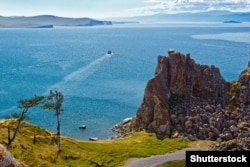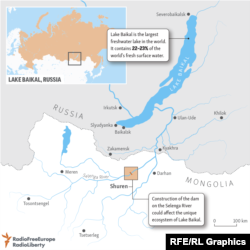Russian environmentalists have condemned a plan by authorities to allow a higher amount of dangerous substances to be dumped into Lake Baikal, which contains about 20 percent of the world's fresh water.
Russia's Natural Resources Ministry earlier this month published draft amendments to a document that establishes the maximum permissible levels of dangerous substances in Lake Baikal's ecosystem.
The new amendments increase several times over the permissible amounts of toxic material that can enter the lake, says Aleksandr Kolotov, head of the local environmental nongovernmental organization Rivers Without Borders.
For example, the maximum allowable amounts of nitrates and anionic synthetic surfactants increase 14 and 10 times, respectively. The upper limit of oil products in wastewater dumped into the lake increases 1.8 times.
Kolotov told the Siberia Desk of RFE/RL's Russian Service that the current standards for the construction of wastewater-treatment plants impose strict requirements on the quality of water discharged into Baikal.
Kolotov said there are two fundamentally different approaches to solving the problem: either to improve the purification technology that would increase the cost of wastewater treatment plants, or lower the standards.
"Obviously, the officials decided to take the second path, treating the unique UNESCO World Heritage site like an ordinary fishery reservoir," Kolotov said.
World's Oldest Lake
Located in Siberia, Baikal is home to more than 3,000 species of plants and animals, about 80 percent of which are unique to that ecosystem.
Baikal is estimated to be some 25 million years old, the oldest lake in the world. At 1,637 meters, it’s also the deepest freshwater lake on the planet, while the average depth is 758 meters. It was declared a UNESCO World Heritage Site in 1996.
Baikal has long faced an environmental crisis. On March 24, hundreds of activists held a rally For A Clean Baikal in the Siberian city of Irkutsk.
Holding banners that read Baikal Is Our Home and Save Baikal, the demonstrators demanded a permanent ban on the construction of a Chinese bottling plant on Lake Baikal that was halted earlier this month after inspections uncovered violations.
In 2017, under pressure from environmentalists, the World Bank froze its tender process for a Mongolian project to construct a hydroelectric station on the Selenga River, a major main inlet source for Baikal.
Critics warned that the project could irreversibly harm Baikal and lead to the extinction of some of the thousands of endemic plant and animal species that live in the lake.
Negative Biodiversity Changes
At the time, Kolotov told RFE/RL that, according to the preliminary findings by experts of the Russian Academy of Sciences, if the Selenga project were built the hydrological situation would change dramatically.
"Dams, in order to ensure stable electricity generation, sometimes reduce the flow and sometimes increase it. This is a huge blow to the ecosystem, which has lived for thousands of years under completely different rules," the expert said.
Baikal’s ecosystem was significantly altered in the 1950s when the Soviet Union built the Irkutsk hydropower plant on Angara, the only major river that flows out of Baikal.
In recent years, the lake has witnessed negative changes in its biodiversity, including the disappearance of the omul fish, a species of the salmon family that was found only in Baikal.
Russian authorities warned in 2017 that the total biomass of omul in the lake decreased from 25 million tons to just 10 million tons in the past 15 years.
It led the government to ban all commercial fishing of omul in Baikal.
The Baikal freshwater seal population, estimated at to be over 60,000, is reducing in numbers due to hunting, poaching, and pollution.
The Baikal Paper and Pulp Mill, also seen as a source of industry pollution, was closed down in 2013.
In 2012, the government allocated about $420 million to a Baikal cleanup project, but some experts argued that the money was not properly spent.












